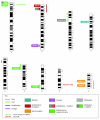The emerging molecular pathogenesis of neuroblastoma: implications for improved risk assessment and targeted therapy
- PMID: 19638189
- PMCID: PMC2717400
- DOI: 10.1186/gm74
The emerging molecular pathogenesis of neuroblastoma: implications for improved risk assessment and targeted therapy
Abstract
Neuroblastoma is one of the most common solid tumors of childhood, arising from immature sympathetic nervous system cells. The clinical course of patients with neuroblastoma is highly variable, ranging from spontaneous regression to widespread metastatic disease. Although the outcome for children with cancer has improved considerably during the past decades, the prognosis of children with aggressive neuroblastoma remains dismal. The clinical heterogeneity of neuroblastoma mirrors the biological and genetic heterogeneity of these tumors. Ploidy and MYCN amplification have been used as genetic markers for risk stratification and therapeutic decision making, and, more recently, gene expression profiling and genome-wide DNA copy number analysis have come into the picture as sensitive and specific tools for assessing prognosis. The applica tion of new genetic tools also led to the discovery of an important familial neuroblastoma cancer gene, ALK, which is mutated in approximately 8% of sporadic tumors, and genome-wide association studies have unveiled loci with risk alleles for neuroblastoma development. For some of the genomic regions that are deleted in some neuroblastomas, on 1p, 3p and 11q, candidate tumor suppressor genes have been identified. In addition, evidence has emerged for the contribution of epigenetic disturbances in neuroblastoma oncogenesis. As in other cancer entities, altered microRNA expression is also being recognized as an important player in neuroblastoma. The recent successes in unraveling the genetic basis of neuroblastoma are now opening opportunities for development of targeted therapies.
Figures

Similar articles
-
FISH analyses for alterations in chromosomes 1, 2, 3, and 11 define high-risk groups in neuroblastoma.Med Pediatr Oncol. 2003 Jul;41(1):30-5. doi: 10.1002/mpo.10313. Med Pediatr Oncol. 2003. PMID: 12764740
-
Nervous system: Embryonal tumors: Neuroblastoma.Atlas Genet Cytogenet Oncol Haematol. 2020 Jul;24(7):284-290. doi: 10.4267/2042/70771. Atlas Genet Cytogenet Oncol Haematol. 2020. PMID: 32296467 Free PMC article.
-
The Detection of Genetic Parameters for Prognostic Stratification of Neuroblastoma Using Multiplex Ligation-Dependent Probe Amplification Technique.Genet Test Mol Biomarkers. 2016 Feb;20(2):74-80. doi: 10.1089/gtmb.2015.0165. Epub 2016 Jan 20. Genet Test Mol Biomarkers. 2016. PMID: 26790040 Clinical Trial.
-
Recent insights into the biology of neuroblastoma.Int J Cancer. 2014 Nov 15;135(10):2249-61. doi: 10.1002/ijc.29077. Epub 2014 Aug 14. Int J Cancer. 2014. PMID: 25124476 Review.
-
Neuroblastoma epigenetics: from candidate gene approaches to genome-wide screenings.Epigenetics. 2011 Aug;6(8):962-70. doi: 10.4161/epi.6.8.16516. Epub 2011 Aug 1. Epigenetics. 2011. PMID: 21725203 Review.
Cited by
-
Co-localization of the oncogenic transcription factor MYCN and the DNA methyl binding protein MeCP2 at genomic sites in neuroblastoma.PLoS One. 2011;6(6):e21436. doi: 10.1371/journal.pone.0021436. Epub 2011 Jun 22. PLoS One. 2011. PMID: 21731748 Free PMC article.
-
Neuropeptide Y as a Biomarker and Therapeutic Target for Neuroblastoma.Am J Pathol. 2016 Nov;186(11):3040-3053. doi: 10.1016/j.ajpath.2016.07.019. Epub 2016 Oct 12. Am J Pathol. 2016. PMID: 27743558 Free PMC article.
-
Tandem NBPF 3mer HORs (Olduvai triplets) in Neanderthal and two novel HOR tandem arrays in human chromosome 1 T2T-CHM13 assembly.Sci Rep. 2023 Sep 2;13(1):14420. doi: 10.1038/s41598-023-41517-3. Sci Rep. 2023. PMID: 37660151 Free PMC article.
-
Selective inhibition of HDAC8 decreases neuroblastoma growth in vitro and in vivo and enhances retinoic acid-mediated differentiation.Cell Death Dis. 2015 Feb 19;6(2):e1657. doi: 10.1038/cddis.2015.24. Cell Death Dis. 2015. PMID: 25695609 Free PMC article.
-
Neuroblastoma Breakpoint Family 3mer Higher Order Repeats/Olduvai Triplet Pattern in the Complete Genome of Human and Nonhuman Primates and Relation to Cognitive Capacity.Genes (Basel). 2024 Dec 13;15(12):1598. doi: 10.3390/genes15121598. Genes (Basel). 2024. PMID: 39766865 Free PMC article.
References
-
- Cohn SL, Pearson AD, London WB, Monclair T, Ambros PF, Brodeur GM, Faldum A, Hero B, Iehara T, Machin D, Mosseri V, Simon T, Garaventa A, Castel V, Matthay KK. The International Neuroblastoma Risk Group (INRG) classification system: an INRG Task Force report. J Clin Oncol. 2009;27:289–297. doi: 10.1200/JCO.2008.16.6785. - DOI - PMC - PubMed
-
- Monclair T, Brodeur GM, Ambros PF, Brisse HJ, Cecchetto G, Holmes K, Kaneko M, London WB, Matthay KK, Nuchtern JG, von Schweinitz D, Simon T, Cohn SL, Pearson AD. The International Neuroblastoma Risk Group (INRG) staging system: an INRG Task Force report. J Clin Oncol. 2009;27:298–303. doi: 10.1200/JCO.2008.16.6876. - DOI - PMC - PubMed
-
- Ambros PF, Ambros IM, Brodeur GM, Haber M, Khan J, Nakagawara A, Schleiermacher G, Speleman F, Spitz R, London WB, Cohn SL, Pearson AD, Maris JM. International consensus for neuroblastoma molecular diagnostics: report from the International Neuroblastoma Risk Group (INRG) Biology Committee. Br J Cancer. 2009;100:1471–1482. doi: 10.1038/sj.bjc.6605014. - DOI - PMC - PubMed
LinkOut - more resources
Full Text Sources
Other Literature Sources
Medical
Research Materials
Miscellaneous

